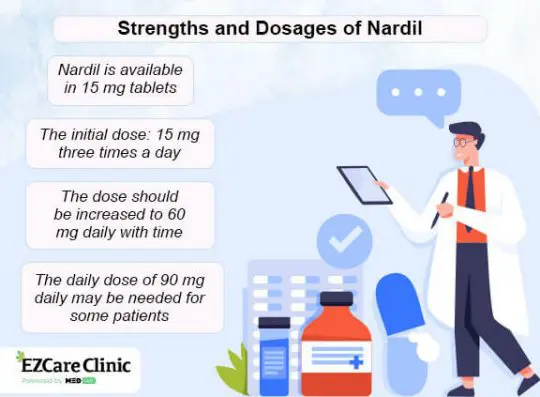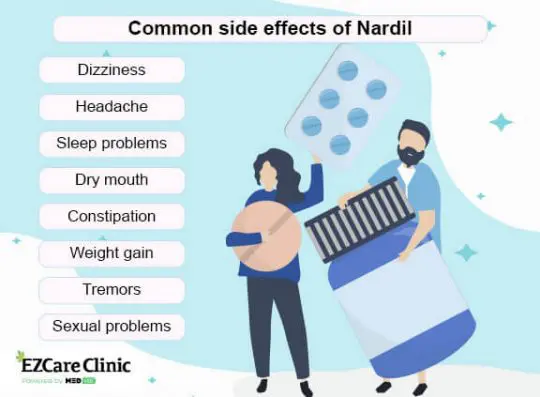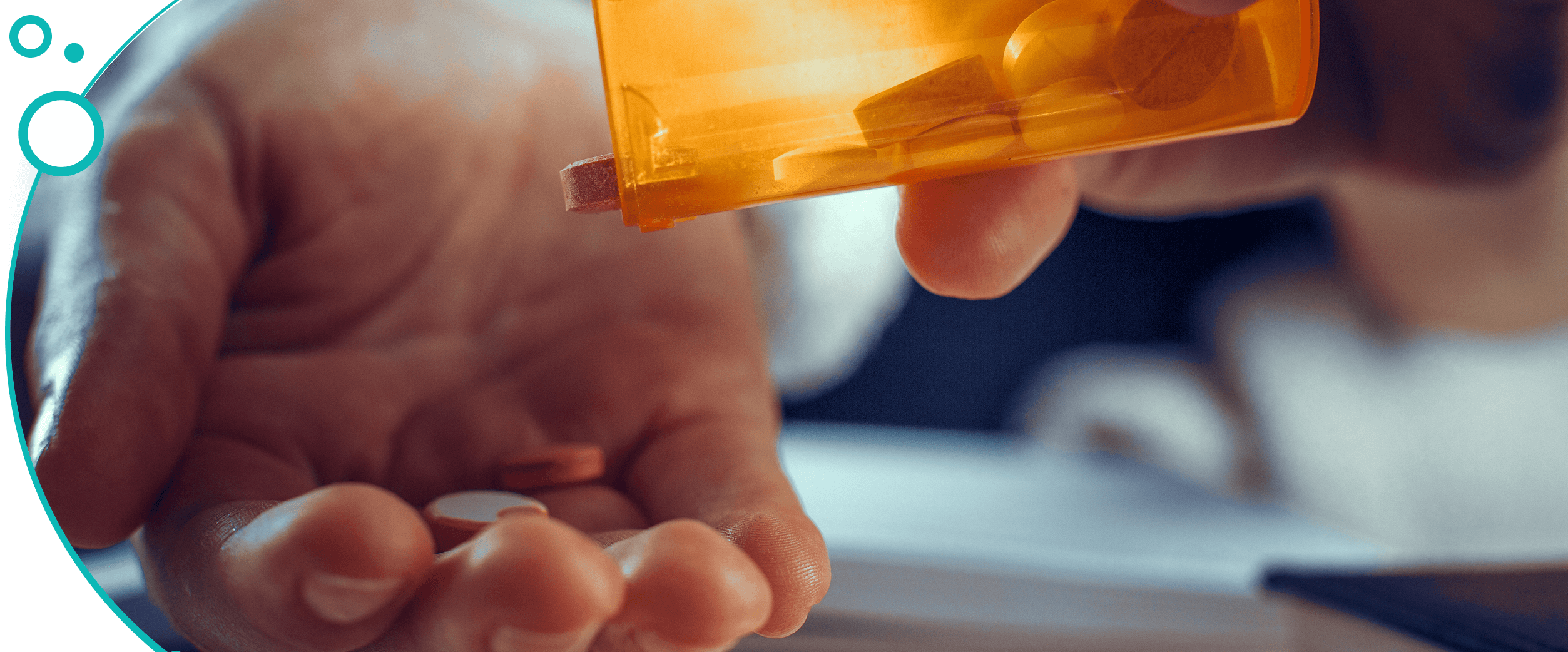The medications listed on this website are provided for informational purposes only. Their inclusion does not guarantee that they will be prescribed to any individual, as treatment decisions are ultimately at the discretion of healthcare providers. This list is not exhaustive, and healthcare providers may prescribe other medications, including non-stimulant options, based on the patient's unique health circumstances and needs.
Major depression is a common mental disorder in America, with at least
Patients having atypical, neurotic, or non-endogenous depression benefit most from Nardil as they usually have symptoms of both depression and anxiety, as well as the signs of different phobias. Aside from the general effectiveness of the chosen medication and possible side effects, patients usually want to know how quickly they would notice the effect. In this post, we’ll try to answer this question and help you know more facts about Nardil.
Consult EZCare doctors to get a diagnosis and proper treatment for depression.
Nardil Drug Class
Nardil belongs to a class of drugs known as monoamine oxidase inhibitors (MAOI). They inhibit the monoamine oxidase enzyme that is responsible for the breakdown of neurotransmitters in the brain. As a result, they balance neurotransmitter (serotonin, dopamine, norepinephrine) levels in a patient’s brain. Doctors typically recommend MAOI to treat depression with atypical nature, but only as a last resort when other medications fail.
Phenelzine Dose
Patients should read the medication guide provided by the pharmacist and take the Nardil dose as directed by their doctor.
The initial Nardil dose is one 15 mg tablet taken three times daily, with or without food. The doctor can gradually increase the dosage to about 60 mg daily, according to the patient’s tolerance.
If the person is not responsive to the medication, the doctor might increase the prescription to 90 mg daily, given in three or four divided doses. Once the patient displays maximum benefit, the doctor will gradually reduce the dosage over several weeks, usually to about 15 mg daily for as long as needed.
If a patient misses a dose, they should take it as soon as possible so as not to increase the chances of relapsing. However, patients should not take two doses simultaneously, so they should skip the missed one if it is almost time for the next dose. Also, patients should not stop Nardil abruptly as it could cause induced withdrawal symptoms.
How Long Does It Take for Nardil to Work
Various factors can affect drug effectiveness, and the time frame it takes for a medicine to impart its full benefits differ from person to person. These factors include:
- Weight, age, and gender of the patient
- Individual’s drug tolerance levels
- Drug dosage
- Any comorbid physical or mental illnesses
- Medication history
- Compliance with the treatment
The typical patient will not display a clinical response until their Nardil dose is increased to 60 mg daily for at least four weeks.

Nardil has a
Researchers could recover about 70% of the Phenelzine dose in the urine after 96 hours if the patient took a 30 mg dose. Nardil will not be present in the blood to remain active.
Patients will start seeing improvements in appetite, sleep, and energy levels in the first two weeks of taking Phenelzine. They may need 6-8 weeks to see improvements in mood and other associated depressive symptoms.
Side Effects of Phenelzine
Medicinal drugs affect people differently, so not everyone will display the same side effect after taking the Nardil medication. Some will not display side effects at all, while some will experience common symptoms. The typical side effects of using Nardil for anxiety and depression treatment are disclosed below.
Each antidepressant has pros and cons, Consult a professional to get suitable and effective meds prescribed.
Common Nardil Side Effects
- Metabolic: Weight gain
- Cardiovascular issues: edema, postural hypotension
- Genitourinary effects: problems with erection and anorgasmia
- Gastrointestinal: dry mouth, constipation, stomach disturbances
- Nervous system: fatigue, dizziness, tremors, twitching, headache, sleep disturbance
Moderate Side Effects of Nardil
- Metabolic: hypernatremia
- Senses: glaucoma, blurred vision
- Nervous system: euphoria, palilalia (a language disorder), jitteriness
- Dermatologic: sweating, skin rash
- Genitourinary: urine retention
Severe Phenelzine Side Effects (Rare)
- Fever with increased muscle tension
- Metabolic: muscular rigidity, hypermetabolic syndrome, hypoxia
- Respiratory: edema of glottis
- Nervous system: toxic delirium, chock-like coma, convulsions, ataxia, manic reaction, an acute anxiety reaction
- Immunologic: lupus-like syndrome
- Hematologic: leukopenia
- Gastrointestinal: reversible jaundice, fatal progressive necrotizing hepatocellular damage
Nardil also comes with the FDA’s black box warning that it can increase the risk of suicidal thinking in children, adolescents, and young adults (up to 24 years). Therefore, this group should be monitored more closely during treatment with Nardil.

Nardil Withdrawal
Although phenelzine is not addictive, patients will likely experience Nardil withdrawal symptoms if they stop using it abruptly. Some discontinuation syndrome symptoms include rushed speech, nausea, hallucinations, delirium, vomiting, insomnia, drowsiness, malaise, severe anxiety, and paranoid psychosis.
Drug Interactions
Some other drugs and products may interact with Nardil, changing how it works or causing adverse side effects. These include:
- attention deficit disorder drugs,
- appetite suppressants,
- drugs for heart and high blood pressure,
- other MAOIs,
- Parkinson’s disease medication,
- some opioid prescriptions,
- “triptan” migraine drugs,
- street drugs like LSD and cocaine,
- serotonin-increasing drugs, such as SSRIs and SNRIs, “ecstasy,” and St. John’s wort, as they will increase the chances of serotonin toxicity (syndrome) when used with Nardil
- tricyclic antidepressants (TCAs),
- medications causing drowsiness and muscle relaxation
- antihistamines,
- sleep and anxiety drugs.
The doctor will also put restrictions on consuming alcohol when taking Nardil. Also, Nardil users should watch their diet, avoiding beverages with caffeine and foods high in tyramine, such as cheese, beef, chicken, and smoked or processed meat and fish.
Final Word
Nardil for depression relief often requires a 60 mg (and over) dosage to work as needed, depending on the patient’s tolerance levels. Even at that dosage, it may take two weeks to record clinical response and 6-8 weeks for the patient to notice a change in mood. If you want to know whether Nardil is a good treatment choice for you and whether it will work fast in your case, consult EZCare doctors today.
Expert help for mental health issues.
Get treatment from licensed healthcare professionals.



